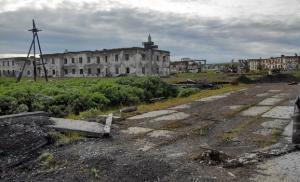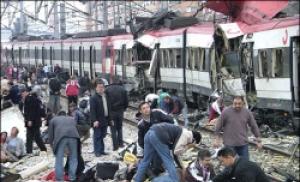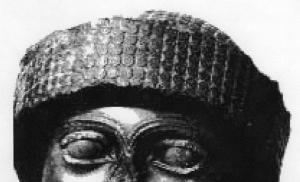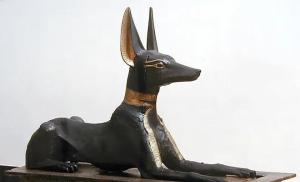Is there life in Death Valley? Halmer-Y. Images of nuclear winter Halmer-U - online map with satellite view: streets, houses, districts and other objects
Halmer-Yu- This is one of the ghost towns in the Urals. Here, in a beautiful place in the middle of the tundra, near the Ural mountains, there are apartment buildings, administrative buildings and industrial facilities abandoned forever by people. Urban trip lovers will feel like in paradise here.
Coordinates for GPS navigator
67.94424004834782, 64.73661371923828
Halmer-Yu ghost town on the map
Khalmer-Yu is located in the Komi Republic, approximately 60-70 kilometers northeast of the city of Vorkuta. The name of the former village is translated from Nenets as “river in the valley of death” or “dead river”. It is curious that in the past the Nenets considered this place sacred. They brought the dead here to bury them.
In 1942, geologists discovered rich coal deposits in this place. An entire novel could be written about that first geological expedition in these places. Due to bad weather, the geologists working here found themselves completely cut off from Vorkuta. Attempts to find and save people one after another ended in failure. So, an attempt was made to at least deliver food for the geologists using deer, but out of hundreds of deer, almost all died. Because of the moss frozen in the ice, they had nothing to eat. Only 14 deer returned alive back to Vorkuta, never reaching the “valley of death.” Only a few months later, in January, were geologists able to find and rescue. All of them were in a state of extreme exhaustion and could no longer move independently.
However, the following year two and a half hundred people already lived here. Exploration of a valuable deposit for the country was carried out. The importance of the K14 grade coal lying here, necessary in coke production, was enormous during the war years. Three deep pits were drilled here, and an exploration and exploitation adit was also laid.
In 1951, construction of a capital mine began in Halmer-Yu. In 1957, the mine was put into operation. The working conditions of the miners were not easy. Great difficulties were created due to the steep bedding of the layers. On average, the mine produced 250 tons of coal per day, which is quite a bit for industry.
The population of Halmer-Yu in the past ranged from 4 to 7.7 thousand people. The village had a developed social sphere. There was a House of Culture, a library, two kindergartens and a nursery, a general education and music school, a school for working youth, a hospital, a dispensary, a hostel, a service center, a bakery, and shops. In addition, the northernmost weather station in Komi was located here.
Halmer-Yu was connected to Vorkuta by a narrow-gauge railway. In the past, a train ran between Halmer-Yu and Vorkuta twice a day. But there was no road here. The embankment of the railway (it serves as a road for people traveling here), a dilapidated station building, and the remains of a locomotive have survived to this day.
After the country's transition to a market economy, difficult times came for the village. At the end of 1993, it was decided to liquidate the mine due to unprofitability and depletion of reserves. By 1996, the village itself was liquidated. People were resettled to Vorkuta and other regions of Russia. However, not everyone wanted to leave their homes. Some people were evicted from Halmer-Yu by force - riot police knocked down apartment doors and led residents out in handcuffs, escorting them to Vorkuta. Since then, former residential houses, administrative and industrial buildings have remained in the tundra. Since the 2000s, the village has been used as a military training ground.
Former residents of this settlement still remember their homeland with nostalgia. An excellent proof of this is several sites on the Internet that unite people who lived here. For many former Halmerus residents, this place continues to be the most beautiful and beloved. Some of them come from time to time to the village in which they were born and raised. They visit their native places, find houses and apartments in which they once lived...
Now in the “Valley of Death” there are only dilapidated boxes of houses with hundreds of empty “eye sockets”, abandoned playgrounds, and here and there children’s toys and things that have been left here forever. Now only stone buildings have survived, and all wooden buildings have been burned by looters and the military.
In addition to the ghost town itself, tourists are interested in the beautiful northern nature surrounding it. Picturesque tundra, rich in berries, reading a river with numerous fish. From the village you can clearly see the snow-capped Ural Mountains rising on the horizon.
25 kilometers north of the village there is one of the largest waterfalls in the European part of our country - the Halmer-Yu waterfall. The height of the water fall here reaches 10 meters. This waterfall is a natural monument.
How to get to Kharmel-U?
Khalmer-Yu is located 70 km northeast of the city of Vorkuta in the Komi Republic. There is no road as such here. You can only drive all-terrain vehicles or good SUVs along the embankment of the former narrow-gauge railway. Yes, and it’s very blurry in places. Passenger trains run to Vorkuta. There is also an airport in Vorkuta.
 Photo by: gromozeka07b9
Photo by: gromozeka07b9  Photo by: gromozeka07b9
Photo by: gromozeka07b9  Photo by: gromozeka07b9
Photo by: gromozeka07b9  Photo by: gromozeka07b9
Photo by: gromozeka07b9  Photo by: gromozeka07b9
Photo by: gromozeka07b9  Photo by: gromozeka07b9
Photo by: gromozeka07b9  Photo by: gromozeka07b9
Photo by: gromozeka07b9  Photo by: gromozeka07b9
Photo by: gromozeka07b9  Photo by: gromozeka07b9
Photo by: gromozeka07b9  Photo by: gromozeka07b9
Photo by: gromozeka07b9  Photo by: gromozeka07b9
Photo by: gromozeka07b9  Photo by: gromozeka07b9
Photo by: gromozeka07b9  Photo by: gromozeka07b9
Photo by: gromozeka07b9  Photo by: gromozeka07b9
Photo by: gromozeka07b9 
 Photo by: romavredina
Photo by: romavredina  Photo by: romavredina
Photo by: romavredina 
 Photo by: Alexey Divin
Photo by: Alexey Divin  Photo by: Alexey Divin
Photo by: Alexey Divin  Photo by: Alexey Divin
Photo by: Alexey Divin  Photo by: Alexey Divin
Photo by: Alexey Divin  Photo by: Alexey Divin
Photo by: Alexey Divin  Photo by: Alexey Divin
Photo by: Alexey Divin  Photo by: Alexey Divin
Photo by: Alexey Divin  Photo by: Alexey Divin
Photo by: Alexey Divin  Photo by: Alexey Divin
Photo by: Alexey Divin
Adults and children,
No way
Don't go to these
Halmer-Yu walk!
No one will meet you
He won’t offer you a drink;
They will send you rockets
Burn from afar...
The combination "Halmer-U" sounds like a curse in an unknown language of the Germanic group. Meanwhile, in terms of sonority, the Nenets language is somewhat similar to German: “Halmer-U” translated means “River in the Valley of the Dead.” They say that the Samoyeds are here for their dead. And now here the buildings, pillars and pipes that were born near the dead river are dying a sad death. To honor them, you need to walk along the bare sleepers north of Vorkuta. The former mining town of Halmer-Yu begins behind the bridge over the river of the same name, famous for the corpses of the Nenets. The last train to the regional center left Halmer-Yu in October 1995. Then the rails were slowly taken away for scrap.

There is also an old bridge several miles to the south for cars and travelers, but today it is difficult to use. Although, if you could rewind time 40-50 years ago, you could easily get by train straight here, to the northernmost village of the “camp republic” of Komi, where it is closer to the ocean than to the truth:

The edge of the railway world, the former station Halmer-Yu.
And in the beginning there was a war.
In 1942, Donbass was in German hands, and the Russians decided to look for coal from the Nenets. In the fall, a team came to explore the layers near the river. Khalmer-Yu, the sacred river of the Nenets dead. A little to the south, Vorkuta, a strategic center of coal mining, was rapidly being built, where some seventy thousand prisoners worked. A party of geologists on Halmer-Yu was torn away from the world by the lack of roads, they almost died of hunger. The scientists were saved in winter by skiers from Vorkuta. The war ended, the layers were explored little by little, and a railway was built. And now, after amnesties and revelations, the northernmost mine of the Vorkutaugol trust began operating, and with it the town of the same name, Halmer-Yu, 80 km from Vorkuta, in a word, at the end of the world. In 1957, hard workers and romantics from all the republics of the USSR came here for northern salaries. Mining 250 tons of coal in a day was very good. Production was stable.


The village grew quickly and soon accommodated 7 thousand people. Local coking coal of excellent quality was the best in the world and the most expensive in the Union: unlike prisoners, free miners received salaries with an 80% northern bonus for work in the deepest mines of the Arctic. If a miner in Kuzbass received 900 Soviet rubles a month, then a colleague from Halmerjus received more than 1600. For this money you could buy a tour around Europe and not deny yourself anything.
By the mid-1980s, a village council was formed in Halmer-Yu, residents ate bread from a local bakery and meat from local pig farms, children went to 2 kindergartens, and the older ones even went to a music school. When houses were barricaded with snow, assignments for schoolchildren were dictated by radio. The length of the town's streets was almost 20 km (for lovers to walk half the night).
But everything came to an end with the collapse of the USSR. In 1993, the Russian authorities declared the mine unprofitable and subject to liquidation along with the village. According to the resolution of the Council of Ministers, residents were given the right to compensation for the purchase of new housing and free travel to a new place of residence. But in the era of hyperinflation, compensation rubles quickly lost weight and were eaten away and drunk. New houses hovered in a fog of breakfast promises. So the stubborn citizens of Halmer-Yu, including camp inmates who were not entitled to a bonus from the authorities, somehow survived until the winter of 1995, when the boiler room in the village was turned off and closed. They warmed themselves with “goats” and were in no hurry to leave their houses with furniture and repairs - they had not yet been given new ones. The final eviction of Halmer-Yu was carried out by riot police - with knocking down doors, children's crying and unkind "packing" of people onto a train to Vorkuta, where the evictees were given musty rooms in dorms. Many “intermediaries” of the reorganization of the Pechora basin have warmed their hands against the backdrop of inflation. Marauders appeared in the abandoned city, and some of them were caught by riot police. The city became a Mystery.


So that the Secret would not be lost in vain, a secret training ground “Pemboy” was created from it (nearby stands the mountain of the same name, a natural monument). Houses in Halmer-Yu, where the warmth of people and faith in the best reigned for almost 40 years, began to be called “conditional targets” (for example, “a lonely hospital”)...
In 2005, Vladimir Putin deigned to mock the corpse of a working-class town. Controlling a Tu-160 bomber (also known as the White Swan), the president fired three super-precision missiles at the House of Culture in the town of Halmer-Yu from a distance of 3 thousand kilometers to the target. One missed...
This is what this cultural center was like in the old days, under the Soviets:

And this is what its surroundings look like now, after the “bang-bang” from above:

In the exercises of that time, the missile forces had a lot of fun, and the results of the war games are not hidden. Extreme tourists are delighted:



Tall buildings in the middle of the barren tundra are ideal targets for missile strikes. But while the lights of Vorkuta flicker nearby, the growth of atomic “mushrooms” over Death Valley is not predicted. Therefore, we hasten to note that there are beautiful waterfalls on the Halmer-Yu River. Which we recommend that you dare to visit:) 
If one day you come across a person on the Internet who claims that Vladimir Putin personally bombed a Russian city, do not rush to declare him an extravagant political provocateur: this is partly true. Just not a city, but an urban village. And not inhabited by people, but resettled 10 years before. It happened in August 2005 during exercises at a military training ground, which was once a mining village and was called Halmer-Yu. But first things first.
The ruins of the former urban village of Khalmer-Yu are located 60 km northeast of Vorkuta, Komi Republic. The name of the former village is translated from Nenets as “river near the cemetery”: even before the appearance of the village, the Nenets considered this place sacred and buried their dead here.
2.

Like all settlements in this part of Komi, Halmer-Yu owes its birth to coal. In 1942, the geological party G.A. Ivanova discovered rich deposits of high quality coal in this place. This expedition almost ended tragically: due to bad weather, the geologists were cut off from Vorkuta, and rescuers were able to reach them only several months later.
3.

The population of Halmer-Yu ranged from 4 to 7.7 thousand people, and the number of residents began to decline not in perestroika times, but since 1959.
By the standards of the Far North, life in the village was not bad: a community center, a library, two kindergartens and a nursery, a general education and music school, a school for working youth, a hospital, a dispensary, a hostel, a service center, a bakery, and shops. In addition, the northernmost weather station in Komi was located here.
4.

During the Soviet years, the northernmost grocery store in the Komi Republic was popular not only among residents of the mining village, but also among reindeer herders from all surrounding areas: they bought cereals, canned food and vodka here for months in advance.
5.

At the end of 1993, it was decided to liquidate the mine due to unprofitability and depletion of reserves. The decree on the liquidation of the mine, signed by Prime Minister Viktor Chernomyrdin, was issued on December 25, 1993. And if there is no mine, then there is no village! In accordance with this document, residents of the village were entitled to compensation for the purchase of housing at the rate of 18 square meters for each family member in the amount of 250 thousand rubles in prices of the second quarter of 1993, with subsequent indexation.
In addition, the government pledged to pay the cost of transporting personal property in the amount of no more than one covered wagon per family, and those leaving the region were entitled to a one-time payment in the amount of four months' salary.
6.

Sociologist Vladimir Ilyin in his work “Power and Coal: The Mining Movement of Vorkuta: 1989-1998” notes that the closure of Halmer-Yu became too expensive for the Russian budget. In addition, as a result of the uncoordinated work of various departments, the liquidation of the village was ahead of the preparation of the base for the resettlement of its residents, since the responsible ministries delayed the allocation of funds.
7.

By the end of October 1995, funding for the resettlement program was completely stopped, and the boiler house was turned off. About a hundred remaining families heated their homes using stoves and electric heaters.
8.

The final liquidation of Halmer-Yu was carried out in 1995 by riot police. According to eyewitnesses, security forces kicked down the doors, herded the last residents into carriages and took them to Vorkuta. Allegedly, the displaced were in no hurry to leave Halmer-Yu, since they had not yet been provided with new housing, and some families received unfinished apartments. As a result, they had to be temporarily placed in hostels and hotels in Vorkuta.
9.

Ruins of the school.
10.

11.

The ruins we see now are not all of Halmer-Yu. Most of the village was made up of wooden houses. But during the resettlement they were all burned; the only reminders of them are the chimneys and frames of the stoves
12.

13.

Patriotic residents often return to Halmer-Yu, especially in the summer.
14.

However, even in winter you can hitchhike here, and it’s easier than you might think: right past the village of Permanent (part of Halmer-Yu) the Vorkuta-Ust-Kara winter road route (the coast of the Kara Sea) passes, and drivers of trucks and all-terrain vehicles, for reasons of northern mutual assistance, willingly take passengers on board
15.

16.

Since the last decade, Halmer-Yu has been part of a military training ground codenamed Pemboy, where cruise missiles are tested. The territory is not fenced or guarded: casual onlookers in these distant lands are a rarity.
17.

Remains of the mine. Construction of the mine began in 1951, it was put into operation in 1957. The design capacity was 600 thousand tons of coal per year, however, it was never achieved. Miscalculations were made during the design, which led to the need for its reconstruction already in the first years of operation of the mine.
Mining operations at the mine ceased in 1994, and by April 1996 it was liquidated. No buildings and structures were dismantled at the mine's industrial site.
18.

19.

Former station building. The only connection with the “mainland” was a single-track narrow-gauge railway to Vorkuta. A train of 2-3 passenger and 1-2 mail and luggage cars ran twice a day, the travel time was 2.5 hours. The last train on this route passed on October 30, 1995.
20.

Now the railway has been dismantled, its embankment is the only more or less reliable way to get to the ghost village.
21.

During an all-terrain expedition to the Arctic in 2006

Photos from Halmer-U at the “Young Photographers of Russia-2017” competition.
26.

In the photo, by the way, is the same building at which, according to the most common version, President Putin shot. But there are also versions that he shot at other structures altogether, and not at the cultural center.
About the inscription, too, not everything is clear: either it was painted as a response to that very shot of the Tu-160 strategic bomber with the president on board, or it was here back in the late nineties, when the building began to fall apart.
27.

photo from 1997: the houses are still relatively intact, the village resembles today’s Vorkuta
28.

29.

30.

31.

32.
P.S. A story about the closure of the village on Vorkuta TV. 1996
33.
P.P.S.: a gloomy track about the village from the domestic dark ambient artist Velehentor
It is impossible to imagine the Far North of post-Soviet Russia without ghost towns that flourished under the USSR, but could not withstand the clash with capitalism. Following the work, be it a withdrawn garrison, an empty port or a mine that stopped working, the infrastructure collapsed, boiler houses burst, supplies became scarce, and in the end some villages were spontaneously abandoned to the last inhabitant, while others were “closed”, that is, abolished and resettled centrally: the cold Far North then gave no less flow of refugees than the hot spots of the Caucasus... Dozens of dead villages continue to stand in deserted and clean land, gradually being destroyed by winds and frosts, and perhaps the most famous of the northern ghost towns is Halmer-Yu near Vorkuta , the most distant of its mining villages, not even included in . For the first time I thought about going there as a student, about ten years ago, but now it has become the first point of our off-road polar journey on the shown beast-machines.
To begin with, we can remember that it is not in vain that it is located BEHIND the Petsets station on the Pechora highway. In 1931, in the Polar Urals, that is, in the deepest rear of the USSR, geologist Georgy Chernov found a whole pool of extremely high-quality coal, on which a year later the first one appeared within the boundaries of Vorkuta. Then there was “Vorkutlag” - one of the largest and most famous islands of the Gulag, there was the North Pechora Mainline, there were supplies of coal to Moscow and Leningrad, which allowed the capitals to hold out while the Germans occupied the Donbass, and there was, finally, the post-war transformation of Vorkuta from the “capital of prisoners” into “the capital of the world” with a stunning interweaving of destinies: I remember how in 2011 a Belarusian, a Lithuanian, a Russian German and a Ukrainian from Lugansk were traveling with me in a compartment of a Vorkuta train... I nicknamed Vorkuta then Polar Odessa - despite the gloom of its landscapes, it a city of interesting, warm and cheerful people, where every Gopnik promised to protect me from any other Gopnik. And although since the collapse of the USSR the population of Vorkuta has decreased by one and a half times (from 100 to 60 thousand in the city itself, from 180 to 110 thousand in the entire agglomeration), and out of 17 mines only five remain, Vorkuta produces almost a quarter of Russia’s coking coal production, and life this goes on as usual.
The Pechora Mainline ( || || ) for the passenger ends at a station on the southern outskirts of Vorkuta (where this time I spent almost a day in the rest rooms, waiting for the arrival of the expedition), but the railways wind further, and locomotives in Severstal livery scurry along them " - now Vorkuta is essentially a colony of Cherepovets, supplying coal to its giant metallurgical plant.
The Pechora highway now does not break off, but loops around, penetrating the villages of the Vorkuta ring, which was actually opened in the 1990-2000s - all that remains is Severny in the east and Vorgashor in the west, and between them there are now only the ghostly Yurshor and Promyshlenny. We drove out to the ring “to the north”, and the landscapes of the industrial area in the bare, cold and poisoned by industrial emissions tundra cannot be confused with anything:
For us these are ruins, but for others Petrovich lived here:
Here someone first heard that snow and ice are the same water, and for several days he could not believe it, forgetting about toys and putting a glass of snow on the radiator under the stern gaze of the teacher.
Here someone went out to the store and got caught in a snowstorm and wandered around in circles for two hours until he ran into a wall and crawled along it to the nearest entrance, from where only a couple of days later, when the wind died down, he managed to return home:
Here someone was drinking port wine with friends and thinking that he would not go into the mine, but would go to Leningrad and return here on vacation to show off:
And someone left from there on October 30, 1995, finally burning down their empty house in the foreground out of despair:
Actually, don’t be fooled by the deserted appearance of Halmer-Yu: the coils of pipes as in the frame above are nothing more than the communications of the destroyed wooden houses that made up most of the village.
Reindeer herders were also frequent guests here, for whom the nearest store was located in Halmer-Yu, from where they swept away a month's supplies of cereal, tea, sugar, bread and vodka at a time.
The Narts met the bus:
And on the square near the Palace there was an ice town, blackened by the soot of the mines by spring:
We decided to go to the mines, wandering around the village, and I insisted on the larger First, but the headquarters all-terrain vehicle without warning drove off to the Second, and since the drivers of all three cars were going to have lunch there, we just had to follow it past the collapsed Cemetery Bridge rivers:
The ruins of Emergency with a clearly visible mine office building. Basically, the Vorkuta mines were liquidated almost without a trace - the waste heap was dumped back into the shafts, the structures were dismantled. And here at least the buildings of both mines still stand:
There are also waste heaps and snow-covered all-terrain vehicles nearby:
Yes, the beams of geologists, probably not empty in the summer:
There were tracks all around and inside the office, and we realized that the arctic fox had just come here:
I thought of climbing to the top floor and filming from there, but the tilted staircase did not allow me to do so:
View from the window to the mine yard:
Snow, ruins, bright sun... This is how I always imagined nuclear winter:
And our all-terrain vehicles, waiting outside, with their Mad Max-style appearance, completely complete the post-apocalyptic atmosphere... Pay attention to the tracks - there was no ice from the road to the office doors, and we covered these fifty meters in about 15 minutes.
View of Constantinople from the second mine. The sky in the photo, by the way, is not photoshopped - there really is such a not quite earthly light:
Something is driving along the winter road:
With sunset, the wind rose and it became sharply cold - from -30 to -30 even everything we bought before the trip didn’t really help with the wind, and colleagues on the expedition recalled how last year they found themselves in windy -50: “That’s it, I’ll tell you.” I wouldn’t wish it on anyone!” The all-terrain vehicles gathered at the edge of the village and were preparing to move on, and Olga and I went to look at the station - it was still a couple of kilometers from the village, and if from afar it seemed that it was next to a military town, up close we discovered that the military town was even further away village The station itself is a modest Stalinist building, but it is here, and not in Vorkuta, that the real end of the Pechora Mainline:
In the cold wind, the camera's batteries and lens lubrication froze, and with considerable difficulty, getting my hands dirty without gloves, I managed to take only a couple of shots. I popped into the waiting room without a roof, but with walls protecting from the wind, to warm up:
View of the station from the "square" side:
Some other station building is opposite.
A train of 2-3 passenger and 1-2 mail and luggage cars went to Vorkuta twice a day in the morning and in the evening, took 2.5 hours, and was the only way to the outside world - the airfield in Halmer-Yu seemed to have once existed , but the current generation of Khalmeryun residents does not remember him. There was even a video room on the train, where passengers could pass the time on the way, and the location of the station so far from residential areas should not be surprising - the train went like a minibus and stopped where they were waiting for it.
And sometimes a blizzard cut even this thin thread for several days. There is a little less snow near Vorkuta than in Kamchatka, and it’s even interesting what the connection is between the amount of snow and the strength of the bonds of those who left for the mainland.
At the station we were picked up by all-terrain vehicles leaving the village and we drove to the Kara Sea.
In the next part - the polar village of Ust-Kara and the difficult path to it.
Search for a map of a city, village, region or country
Halmer-Y. Yandex map.
Allows you to: change the scale; measure distances; switch display modes - diagram, satellite view, hybrid. The Yandex maps mechanism is used, it contains: districts, street names, house numbers and other objects of cities and large villages, allows you to perform search by address(square, avenue, street + house number, etc.), for example: “Lenin St. 3”, “Halmer-Yu Hotel”, etc.
If you don't find something, try the section Google satellite map: Halmer-U or a vector map from OpenStreetMap: Halmer-Yu.
Link to the object you selected on the map can be sent by e-mail, icq, sms or posted on the website. For example, to show a meeting place, delivery address, location of a store, cinema, train station, etc.: combine the object with the marker in the center of the map, copy the link on the left above the map and send it to the recipient - according to the marker in the center, he will determine the location you specified .
Halmer-Yu - online map with satellite view: streets, houses, areas and other objects.
To change the scale, use the mouse scroll wheel, the “+ -” slider on the left, or the “Zoom in” button in the upper left corner of the map; to view a satellite view or a people's map, select the appropriate menu item in the upper right corner; to measure the distance, click the ruler at the bottom right and plot the points on the map.
Komi Republic - Halmer-Yu: interactive map from Yandex. Vector diagram and satellite photo - with streets and houses, roads, address search and routing, measuring distances, the ability to get a link to a selected object on the map - to send to the recipient or post on the website.













